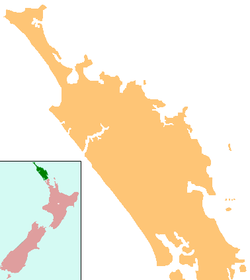Maungatapere
Maungatapere | |
|---|---|
 Maungatapere | |
| Coordinates: 35°45′18″S 174°12′28″E / 35.75500°S 174.20778°ECoordinates: 35°45′18″S 174°12′28″E / 35.75500°S 174.20778°E | |
| Country | New Zealand |
| Region | Northland Region |
| District | Whangarei District |
| Population (2013) | |
| • Total | 1,323 |
Maungatapere is a settlement in Northland, New Zealand. State Highway 14 runs through it. Whangārei is 11 km to the east, and Tangiteroria is 18 km to the south west. The settlement takes its name from a rounded volcanic peak of the same name (a Maori name meaning "meeting house by the mountain") that lies to the southwest, and has a summit 359 meters above sea level.[1][2]
Maungatapere is at the junction of State Highways 14 and 15.
Maungatapere is the antipode of the city of Tangier, Morocco.
Demographics[]
| Year | Pop. | ±% p.a. |
|---|---|---|
| 2006 | 2,757 | — |
| 2013 | 2,994 | +1.19% |
| 2018 | 3,477 | +3.04% |
| Source: [3] | ||
The statistical area of Maungatapere, which at 174 square kilometres is much larger than the settlement, had a population of 3,477 at the 2018 New Zealand census, an increase of 483 people (16.1%) since the 2013 census, and an increase of 720 people (26.1%) since the 2006 census. There were 1,191 households. There were 1,764 males and 1,713 females, giving a sex ratio of 1.03 males per female. Of the total population, 756 people (21.7%) were aged up to 15 years, 501 (14.4%) were 15 to 29, 1,659 (47.7%) were 30 to 64, and 564 (16.2%) were 65 or older. Figures may not add up to the total due to rounding.
Ethnicities were 89.0% European/Pākehā, 19.0% Māori, 1.2% Pacific peoples, 2.9% Asian, and 2.2% other ethnicities. People may identify with more than one ethnicity.
The percentage of people born overseas was 16.2, compared with 27.1% nationally.
Although some people objected to giving their religion, 55.0% had no religion, 34.8% were Christian, and 3.5% had other religions.
Of those at least 15 years old, 531 (19.5%) people had a bachelor or higher degree, and 468 (17.2%) people had no formal qualifications. The median income was $36,500. The employment status of those at least 15 was that 1,446 (53.1%) people were employed full-time, 516 (19.0%) were part-time, and 63 (2.3%) were unemployed.[3]
History[]
Thomas Elmsley bought 60,000 acres (24,000 ha) of land in Maungatapere and northern Wairoa from Te Tirarau Kukupa in 1839, and in 1840 he and the brothers Henry and Charles Walton came with workers to establish farms in the area. Henry Walton's farm was on the slopes of Maungatapere Mountain and was called "Maungatapere Park".[4] After the Flagstaff War, Walton employed former soldiers to build stone walls which are still a feature of the area. Henry Walton married Kohura, Te Tirarau Kukupa's niece, in 1846. After she died in childbirth, he married her sister, Pehi, but she died in a measles epidemic in 1856. Walton built a road between Maungatapere and Whangarei in 1858. He also became involved in coal mining and shipbuilding, and was one of the partners in the timber mill at Te Kōpuru. Walton was one of the founding shareholders in the Bank of New Zealand. In 1863 he became a member of the New Zealand Legislative Council and two years later he was elected to the Auckland Provincial Council. However, in 1867 he left New Zealand and returned to England.[5]
Education[]
Maungatapere School is a coeducational full primary (years 1-8) school with a roll of 335 students (as of November 2021).[6][7] The school celebrated its 125th jubilee in 2004.[8]
Notes[]
- ^ Peter Dowling (editor) (2004). Reed New Zealand Atlas. Reed Books. pp. map 7. ISBN 0-7900-0952-8.CS1 maint: extra text: authors list (link)
- ^ Roger Smith, GeographX (2005). The Geographic Atlas of New Zealand. Robbie Burton. pp. map 24. ISBN 1-877333-20-4.
- ^ a b "Statistical area 1 dataset for 2018 Census". Statistics New Zealand. March 2020. Maungatapere (105400). 2018 Census place summary: Maungatapere
- ^ Pickmere, Nancy Preece (1986). Whangarei: The Founding Years. p. 32.
- ^ Pickmere, p 51-58. Maungatapere Park was eventually sold for subdivision into farms.
- ^ "New Zealand Schools Directory". New Zealand Ministry of Education. Retrieved 22 December 2021.
- ^ Education Counts: Maungatapere School
- ^ "Maungatapere School 125th Jubilee". Education Gazette New Zealand. 83 (3). 23 February 2004.[dead link]
External links[]
- Whangarei District
- Populated places in the Northland Region
